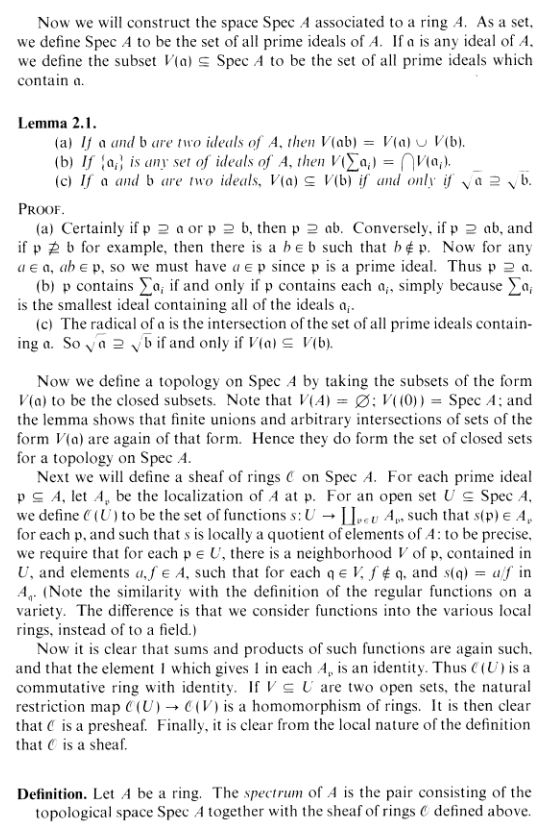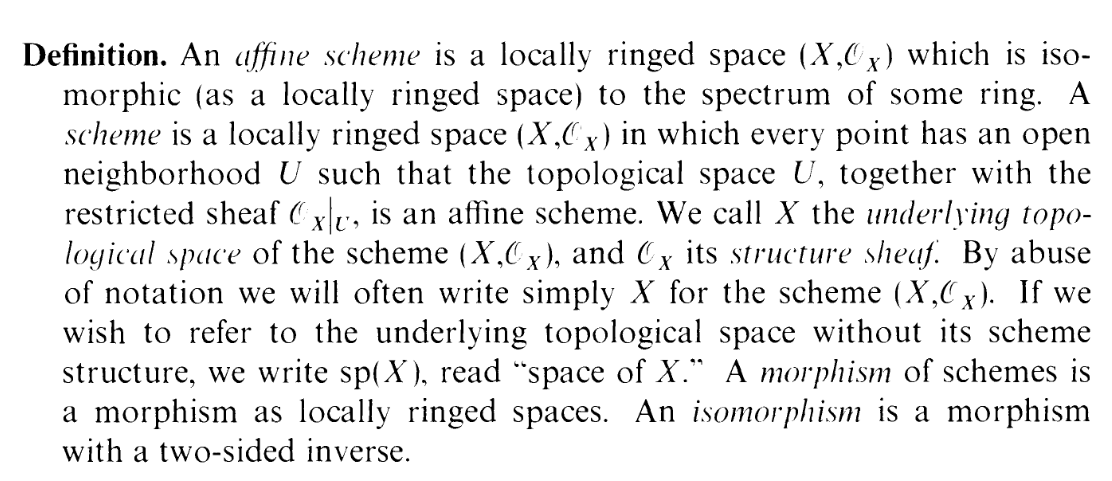II.2.5
1/24/2022

Ah.

GROTHENDIECK! That monster thriving off banana and milk, thrashing
through throves of sheaves and cutting through stalks, scheming about here and
there, sitting underneath layers of density arranged in a dome. His hours
numbering dozen a day, reaching into the midnight, his bare pate kiss'd by the
moonlight. Dwells he in a cathedral crafted out of his own definition, fences
filtering lady suitors; Life worked out of his body, sons left estranged and spirit
unconscious in books in shelves and form beyond. Why take pride in your
biological seed, when your kernel of thought has spread like the dust of the earth,
the land of God's art–mathematics–inherited fruitfully in your name,
thyself spiritually multiplied east and west like Abraham? And still: why
even take pride in that kernel? The ultimate yarn of one's name is his
exposure as death's prey, yet what is in a name's fleshless continuation?
Why live on in your flower distill'd, bottled and transported here and
there and hearkening back to its ancestor, that substance so sweet yet
untasted by bones in grave? Why head a revolution that leaves thee; fight
for a plot that cedes from thy heir? That gracious light of Laplace, and
that sun's sons, may have their golden pilgrimage only finite times oer.
That candle lighted in your lover's bedroom melts with the march of
time. So as faith and faithless are doomed to fake their way, let death do
us apart from any weight of want or want thereof. Our souls lay devoid of
having thought thoughts bloody but whimsical vain, our writhes of war and
rapacious yells but cries for help. And yet, GROTHENDIECK: Eyes somehow
glowing red in a period of decadence; The final mathematician. Alight from
the shrine of Grothy, and let us observe ourself: Oft left want of want,
takes on this 萌やしっ子 a task unbefitting of his lack, in want of that.
For an egg-shell or a straw quarrell'd would he squander his own life,
had he a covenant. But seeing all reduced to paper and pen, and the
globe globbed by a glum glow, he does nothing. He supposes that the
men preceding had something divine, an itch in their soul that made
them feel, a divot that made them be. So upon the field of nothing he
plows for a treasure that shines black, for a fooled man is as good as
gold, ere the rest of silence take it
away.
1 Definitions
Alright, reader. This is is it. This is the big one. What I am about to show
you is the most important definition we will encounter on this blog.
(or, at least, I believe it to be so). Ready? I present to you, the spectrum:

Now, Mr. Robin Hartshorne enjoys being dry with epic facts like Boulez
conducting the finale of a Mahler symphony. Let me explain:
Y'know, y'can get a bunch-a schemes by just plugging rings into the spectrum. Y'can make all sorts of fucked up geometries. Varieties, discrete spaces, elliptic curves–and you can even glue 'em together to make larger schemes. And once you realize that, well, now you've opened up a whole Pandora's box of geometries.
Okay, follow along with me here, EVEN IF YOU'RE NOT MATHEMATICALLY INCLINED, I'll explain this in laymans terms (like I often do to myself in order to understand stuff, lol)
Here's the main point: Given any algebraic structure, Spec makes a geometry on its primes (By algebraic structure I mean rings, and by primes I mean prime ideals).
Take ANY ring you've encountered in your life: Integers, fields like rationals and reals and complex numbers, polynomials, continuous or differentiable functions, integers modulo n, or even more fancy complex rings like polynomials in infinite variables, discrete valuation rings, local rings, etc. If you Spec any of these, you get a geometry on their prime ideals. Whatever algebraic structure you can think of, you can create a geometrical structure on its prime ideals. That's what Spec does (These geometries are called "affine schemes").
It gets even better: you can glue these geometries together to make even bigger geometries:

(where locally ringed spaces are defined here).
THAT, my friends, is the category of schemes.
2 Specing Z
"So, um, what do these geometries look like? Like e.g. what does the spectrum of
the integers look like?" Good question. That's what we'll compute here.
Now, right off the bat, it's well-known that Z is a PID, and furthermore
(therefore) its prime ideals correspond to... THE PRIME NUMBERS. DUH. so as
a set:
 |
So we're going to make a "geometry" on the prime numbers. First
we need to figure out the shape (topology) that Spec gives to these
numbers. Now since Z is a PID, I can iterate over all the closed sets
by just iterating over the integers. And let's try to explicitly compute
the first couple of closed sets by hand, and see if we notice a pattern
| V ((0)) | = SpecZ | ||
| V ((1)) | = ∅ | ||
| V ((2)) | = {(2)} | ||
| V ((3)) | = {(3)} | ||
| V ((4)) | = {(2)} | ||
| V ((5)) | = {(5)} | ||
| V ((6)) | = {(2), (3)} | ||
| V ((7)) | = {(7)} | ||
| V ((8)) | = {(2)} | ||
 |
Yes its obvious in hindsight but do note I screwed this process up at least once
LOL. SO WHAT IS THE PATTERN? *Jeapordy music*
.
.
.
.
.
.
ANSWER:
 |
And furthermore, I can combine any selection of primenumbers to make another
composite number, and since these sets comprise all the closed sets, I can
thus conclude that SpecZ has the finite complement topology.
Okay, now to finish this off let's compute the so-called structure sheaf. I think
D(6) is an illustrative example for this (note that the D(⋅)s comprise the entire
topology cuz PID). Now the basic form here is
 (D(6)) ⊂{s : D(6) (D(6)) ⊂{s : D(6) | →⊔ P∈D(6)ZP} | ||
| = {s : SpecZ -{(2), (3)} | → Z(0) ⊔ Z(5) ⊔ Z(7) ⊔
 } } |
Now what the s's that comprise
 (D(6))? Well we need s(P) ∈ ZP, with a
local rational representation about P. But also note that Z(0) = Q
the rational numbers, and EVERY NBD OF P CONTAINS (0), and
ALSO THAT EACH ZP IS A SUBRING OF Q, so we can just write
s = a∕b, with the condition that b isn't in (0), (5), (7),…. I.e. s = a∕b
where the denominator's prime factorization can only contain 2s and
3s. The generalization is obvious. Talk about "rational functions", eh?
(D(6))? Well we need s(P) ∈ ZP, with a
local rational representation about P. But also note that Z(0) = Q
the rational numbers, and EVERY NBD OF P CONTAINS (0), and
ALSO THAT EACH ZP IS A SUBRING OF Q, so we can just write
s = a∕b, with the condition that b isn't in (0), (5), (7),…. I.e. s = a∕b
where the denominator's prime factorization can only contain 2s and
3s. The generalization is obvious. Talk about "rational functions", eh?
So there you go, that's what Specing the integers looks like. You get a very
"algebraic" geometry on the prime numbers. It looks like we'll be doing a fair
amount of "What happens when you Spec THIS!?" type exercises, so get ready.

I'm sorry sir, you can Spec out any time you like, but you can never leave. IT'S
TWILIIIIIIIIIIIIGHT, BABY. I ONLY MEANT TO
STAY A WHILE .
But SpecZ is not just any geometry. It's a VERY SPECIAL geometry. It's
FINAL. We can map to it from ANY SCHEME in a UNIQUE MANNER.
3 SpecZ is the final scheme
Actually, it's already obvious that Z is initial in the category of rings, and since
Spec is a contravariant functor giving rise to an equivalence of categories
between rings and affine schemes, I know that SpecZ is final as an affine
scheme.
"...Wh....What... the... actual fuck did you just say?"
IT'S JUST ABSTRACT NONSENSE DON'T WORRY ABOUT IT BRO. The
point is that I already have a unique morphism from any affine scheme to
SpecZ. But what about schemes more generally?
Well, pretty much the only fact we're given about schemes is that they're locally
affine, so we pretty much have to rely on that. Ackshually, it turns out that if you
restrict a morphism of schemes to an open set, it's still a morphism (NEW
CHEATSHEET ENTRY COMING SOON). So given a scheme X, and a
morphism δ : X → SpecZ, I know that when I restrict to the open affines
covering X, δ is forced to be given as the corresponding final morphisms to
SpecZ. So that forces a definition of δ; now we just have to confirm that this is
actually a consistent definition. I.e. do these morphisms glue together properly?
Here's how it goes. As I'm typing this realize that the justification I had for
this is completely wrong. And now I have to go back to my notebook
lest I leave this confirmation to this reader. Brb. *Cue Jeopardy music*
.
.
.
.
.
.
.
.
.
.
.
.
.
.
.
.
.
.
.
.
Okay, I am back and I haven't figured this out and I'm supposed to publish
this post in like 30 minutes so let's see if I can figure it out while I'm
typing then. WATCH HOLEINMYHEART DO MATH IN REAL TIME:
First, let me frame the problem: Let U,V be open affines in X. Then there are
unique morphisms
| ϕ : U | → SpecZ | ||
| ψ : V | → SpecZ |
I want to confirm that if P ∈ U ∩ V , we can't have ϕ(P)≠ψ(P).
Okay, let's set A =
 X(U),B =
X(U),B =
 X(V ), so ϕ and ψ are induced from the
initial morphisms ϕ* : Z → A,ψ* : Z → B.
X(V ), so ϕ and ψ are induced from the
initial morphisms ϕ* : Z → A,ψ* : Z → B.
Now, I'd like to pay special attention to the induced morphisms
| ϕP* : Z ϕ(P) | → AP | ||
| ψP* : Z ψ(P) | → BP |
Okay, now the key point, I THINK, is that AP ≃ BP, since they are both the
stalk
 P,X. It definitely has something to do with that, right, reader?
P,X. It definitely has something to do with that, right, reader?
Hmmmm.
.
.
.
.
.
.
.
.
.
.
.
.
OKAY. I GOT IT. Yes, I was on the right track. So remember these are local
rings, right? The key point is that they have a unique maximal ideal. And
morphisms inversely map maximal ideals to maximal ideals. So ϕP
inversely maps PAP = PBP to ϕ(P)Zϕ(P), and ψP likewise inverseley maps
PAP = PBP to ψ(P)Zψ(P), but since maximal ideals are unique, this means
that
All that is wrong, again. And I'm supposed to publish now, so exercise left to
reader. At least I constructed the morphism, lmfao.